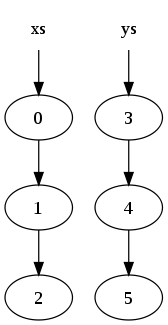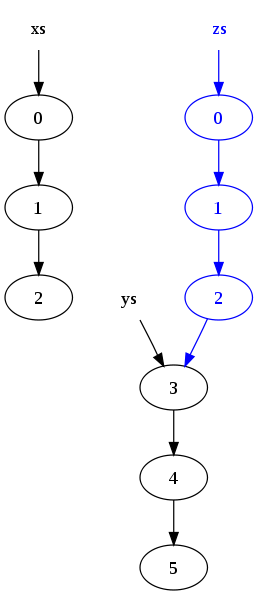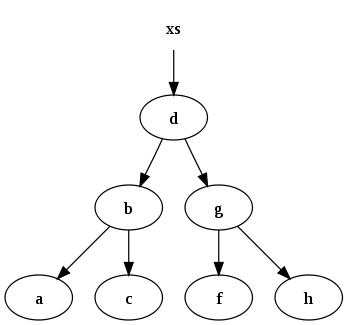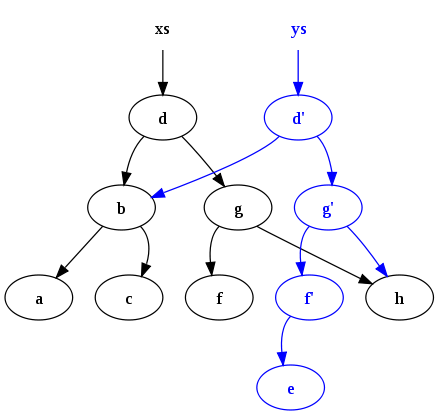
Persistent data structure
Encyclopedia
In computing
, a persistent data structure is a data structure
which always preserves the previous version of itself when it is modified; such data structures are effectively immutable
, as their operations do not (visibly) update the structure in-place, but instead always yield a new updated structure. (A persistent data structure is not a data structure committed to persistent storage, such as a disk; this is a different and unrelated sense of the word "persistent.")
A data structure is partially persistent if all versions can be accessed but only the newest version can be modified. The data structure is fully persistent if every version can be both accessed and modified. If there is also a meld or merge operation that can create a new version from two previous versions, the data structure is called confluently persistent. Structures that are not persistent are called ephemeral.
These types of data structures are particularly common in logical
and functional programming
, and in a purely functional
program all data is immutable, so all data structures are automatically fully persistent. Persistent data structures can also be created using in-place updating of data and these may, in general, use less time or storage space than their purely functional counterparts.
While persistence can be achieved by simple copying, this is inefficient in time and space, because most operations make only small changes to a data structure. A better method is to exploit the similarity between the new and old versions to share structure between them, such as using the same subtree in a number of tree structure
s. However, because it rapidly becomes infeasible to determine how many previous versions share which parts of the structure, and because it is often desirable to discard old versions, this necessitates an environment with garbage collection
.
or cons-based list, a simple list of objects formed by each carrying a reference
to the next in the list. This is persistent because we can take a tail of the list, meaning the last k items for some k, and add new nodes on to the front of it. The tail will not be duplicated, instead becoming shared between both the old list and the new list. So long as the contents of the tail are immutable, this sharing will be invisible to the program.
Many common reference-based data structures, such as red-black tree
s, and queues, can easily be adapted to create a persistent version. Some other like Stack
, Double-ended queues (dequeue), Min-Dequeue (which have additional operation min returning minimal element in constant time without incurring additional complexity on standard operations of queuing and dequeuing on both ends), Random access list (with constant cons/head as single linked list, but with additional operation of random access with sub-linear, most often logarithmic, complexity), Random access queue, Random access double-ended queue and Random access stack (as well Random access Min-List, Min-Queue, Min-Dequeue, Min-Stack) needs slightly more effort.
There exists also persistent data structures which uses destructible operations (thus impossible to implement efficiently in the purely functional languages like Haskell, however possible in languages like C, Java), they are however not needed, as most data structures are currently available in pure versions which are often simpler to implement, and often behaves better in multi-threaded environments.
Singly linked list
s are the bread-and-butter data structure in functional languages. In ML
-derived
languages and Haskell
, they are purely functional because once a node in the list has been allocated, it cannot be modified, only copied or destroyed. Note that ML itself is not purely functional.
Consider the two lists:
xs = [0, 1, 2]
ys = [3, 4, 5]
These would be represented in memory by:

where a circle indicates a node in the list (the arrow out showing the second element of the node which is a pointer to another node).
Now concatenating the two lists:
zs = xs ++ ys
results in the following memory structure:

Notice that the nodes in list
The reason for the copy is that the last node in
be modified to point to the start of
Consider a binary tree
used for fast searching,
where every node has the recursive
invariant
that subnodes on the
left are less than the node, and subnodes on the right
are greater than the node.
For instance, the set of data
xs = [a, b, c, d, f, g, h]
might be represented by the following binary search tree:

A function which inserts data into the binary tree
and maintains the invariant is:
fun insert (x, E) = T (E, x, E)
| insert (x, s as T (a, y, b)) =
if x < y then T (insert (x, a), y, b)
else if x > y then T (a, y, insert (x, b))
else s
After executing
ys = insert ("e", xs)
we end up with the following:

Notice two points: Firstly the original tree (
persists. Secondly many common nodes are shared between
the old tree and the new tree.
Such persistence and sharing is difficult to
manage without some form of garbage collection
(GC) to
automatically free up nodes which have no live
references, and this is why GC is a feature commonly
found in functional programming languages
.
. However, in most functional languages, functions can be defined recursively
; this capability allows recursive structures using functional suspensions. In lazy
languages, such as Haskell
, all data structures are represented as implicitly suspended thunk
s; in these languages any data structure can be recursive because a value can be defined in terms of itself. Some other languages, such as Objective Caml
, allow the explicit definition of recursive values.
Computing
Computing is usually defined as the activity of using and improving computer hardware and software. It is the computer-specific part of information technology...
, a persistent data structure is a data structure
Data structure
In computer science, a data structure is a particular way of storing and organizing data in a computer so that it can be used efficiently.Different kinds of data structures are suited to different kinds of applications, and some are highly specialized to specific tasks...
which always preserves the previous version of itself when it is modified; such data structures are effectively immutable
Immutable object
In object-oriented and functional programming, an immutable object is an object whose state cannot be modified after it is created. This is in contrast to a mutable object, which can be modified after it is created...
, as their operations do not (visibly) update the structure in-place, but instead always yield a new updated structure. (A persistent data structure is not a data structure committed to persistent storage, such as a disk; this is a different and unrelated sense of the word "persistent.")
A data structure is partially persistent if all versions can be accessed but only the newest version can be modified. The data structure is fully persistent if every version can be both accessed and modified. If there is also a meld or merge operation that can create a new version from two previous versions, the data structure is called confluently persistent. Structures that are not persistent are called ephemeral.
These types of data structures are particularly common in logical
Logic programming
Logic programming is, in its broadest sense, the use of mathematical logic for computer programming. In this view of logic programming, which can be traced at least as far back as John McCarthy's [1958] advice-taker proposal, logic is used as a purely declarative representation language, and a...
and functional programming
Functional programming
In computer science, functional programming is a programming paradigm that treats computation as the evaluation of mathematical functions and avoids state and mutable data. It emphasizes the application of functions, in contrast to the imperative programming style, which emphasizes changes in state...
, and in a purely functional
Purely functional
Purely functional is a term in computing used to describe algorithms, data structures or programming languages that exclude destructive modifications...
program all data is immutable, so all data structures are automatically fully persistent. Persistent data structures can also be created using in-place updating of data and these may, in general, use less time or storage space than their purely functional counterparts.
While persistence can be achieved by simple copying, this is inefficient in time and space, because most operations make only small changes to a data structure. A better method is to exploit the similarity between the new and old versions to share structure between them, such as using the same subtree in a number of tree structure
Tree structure
A tree structure is a way of representing the hierarchical nature of a structure in a graphical form. It is named a "tree structure" because the classic representation resembles a tree, even though the chart is generally upside down compared to an actual tree, with the "root" at the top and the...
s. However, because it rapidly becomes infeasible to determine how many previous versions share which parts of the structure, and because it is often desirable to discard old versions, this necessitates an environment with garbage collection
Garbage collection (computer science)
In computer science, garbage collection is a form of automatic memory management. The garbage collector, or just collector, attempts to reclaim garbage, or memory occupied by objects that are no longer in use by the program...
.
Examples of persistent data structures
Perhaps the simplest persistent data structure is the singly linked listLinked list
In computer science, a linked list is a data structure consisting of a group of nodes which together represent a sequence. Under the simplest form, each node is composed of a datum and a reference to the next node in the sequence; more complex variants add additional links...
or cons-based list, a simple list of objects formed by each carrying a reference
Reference
Reference is derived from Middle English referren, from Middle French rèférer, from Latin referre, "to carry back", formed from the prefix re- and ferre, "to bear"...
to the next in the list. This is persistent because we can take a tail of the list, meaning the last k items for some k, and add new nodes on to the front of it. The tail will not be duplicated, instead becoming shared between both the old list and the new list. So long as the contents of the tail are immutable, this sharing will be invisible to the program.
Many common reference-based data structures, such as red-black tree
Red-black tree
A red–black tree is a type of self-balancing binary search tree, a data structure used in computer science, typically to implement associative arrays. The original structure was invented in 1972 by Rudolf Bayer and named "symmetric binary B-tree," but acquired its modern name in a paper in 1978 by...
s, and queues, can easily be adapted to create a persistent version. Some other like Stack
Stack
-Mathematics:* Stack , general category-theoretical concept to formalise "pull-back" operations in geometry and algebra* Algebraic stack, a generalisation of scheme and algebraic space in algebraic geometry; a specific type of the above-Computers:...
, Double-ended queues (dequeue), Min-Dequeue (which have additional operation min returning minimal element in constant time without incurring additional complexity on standard operations of queuing and dequeuing on both ends), Random access list (with constant cons/head as single linked list, but with additional operation of random access with sub-linear, most often logarithmic, complexity), Random access queue, Random access double-ended queue and Random access stack (as well Random access Min-List, Min-Queue, Min-Dequeue, Min-Stack) needs slightly more effort.
There exists also persistent data structures which uses destructible operations (thus impossible to implement efficiently in the purely functional languages like Haskell, however possible in languages like C, Java), they are however not needed, as most data structures are currently available in pure versions which are often simpler to implement, and often behaves better in multi-threaded environments.
Linked lists
This example is taken from Okasaki. See the bibliography.Singly linked list
Linked list
In computer science, a linked list is a data structure consisting of a group of nodes which together represent a sequence. Under the simplest form, each node is composed of a datum and a reference to the next node in the sequence; more complex variants add additional links...
s are the bread-and-butter data structure in functional languages. In ML
ML programming language
ML is a general-purpose functional programming language developed by Robin Milner and others in the early 1970s at the University of Edinburgh, whose syntax is inspired by ISWIM...
-derived
languages and Haskell
Haskell (programming language)
Haskell is a standardized, general-purpose purely functional programming language, with non-strict semantics and strong static typing. It is named after logician Haskell Curry. In Haskell, "a function is a first-class citizen" of the programming language. As a functional programming language, the...
, they are purely functional because once a node in the list has been allocated, it cannot be modified, only copied or destroyed. Note that ML itself is not purely functional.
Consider the two lists:
xs = [0, 1, 2]
ys = [3, 4, 5]
These would be represented in memory by:

where a circle indicates a node in the list (the arrow out showing the second element of the node which is a pointer to another node).
Now concatenating the two lists:
zs = xs ++ ys
results in the following memory structure:

Notice that the nodes in list
xs have been copied, but the nodes in ys are shared. As a result, the original lists (xs and ys) persist and have not been modified.The reason for the copy is that the last node in
xs (the node containing the original value 2) cannotbe modified to point to the start of
ys, because that would change the value of xs.Trees
This example is taken from Okasaki. See the bibliography.Consider a binary tree
Binary tree
In computer science, a binary tree is a tree data structure in which each node has at most two child nodes, usually distinguished as "left" and "right". Nodes with children are parent nodes, and child nodes may contain references to their parents. Outside the tree, there is often a reference to...
used for fast searching,
where every node has the recursive
Recursion
Recursion is the process of repeating items in a self-similar way. For instance, when the surfaces of two mirrors are exactly parallel with each other the nested images that occur are a form of infinite recursion. The term has a variety of meanings specific to a variety of disciplines ranging from...
invariant
Invariant (computer science)
In computer science, a predicate is called an invariant to a sequence of operations provided that: if the predicate is true before starting the sequence, then it is true at the end of the sequence.-Use:...
that subnodes on the
left are less than the node, and subnodes on the right
are greater than the node.
For instance, the set of data
xs = [a, b, c, d, f, g, h]
might be represented by the following binary search tree:

A function which inserts data into the binary tree
and maintains the invariant is:
fun insert (x, E) = T (E, x, E)
| insert (x, s as T (a, y, b)) =
if x < y then T (insert (x, a), y, b)
else if x > y then T (a, y, insert (x, b))
else s
After executing
ys = insert ("e", xs)
we end up with the following:

Notice two points: Firstly the original tree (
xs)persists. Secondly many common nodes are shared between
the old tree and the new tree.
Such persistence and sharing is difficult to
manage without some form of garbage collection
Garbage collection (computer science)
In computer science, garbage collection is a form of automatic memory management. The garbage collector, or just collector, attempts to reclaim garbage, or memory occupied by objects that are no longer in use by the program...
(GC) to
automatically free up nodes which have no live
references, and this is why GC is a feature commonly
found in functional programming languages
Functional programming
In computer science, functional programming is a programming paradigm that treats computation as the evaluation of mathematical functions and avoids state and mutable data. It emphasizes the application of functions, in contrast to the imperative programming style, which emphasizes changes in state...
.
Reference cycles
Since every value in a purely functional computation is built up out of existing values, it would seem that it is impossible to create a cycle of references. In that case, the reference graph (the graph of the references from object to object) could only be a directed acyclic graphDirected acyclic graph
In mathematics and computer science, a directed acyclic graph , is a directed graph with no directed cycles. That is, it is formed by a collection of vertices and directed edges, each edge connecting one vertex to another, such that there is no way to start at some vertex v and follow a sequence of...
. However, in most functional languages, functions can be defined recursively
Recursion
Recursion is the process of repeating items in a self-similar way. For instance, when the surfaces of two mirrors are exactly parallel with each other the nested images that occur are a form of infinite recursion. The term has a variety of meanings specific to a variety of disciplines ranging from...
; this capability allows recursive structures using functional suspensions. In lazy
Lazy evaluation
In programming language theory, lazy evaluation or call-by-need is an evaluation strategy which delays the evaluation of an expression until the value of this is actually required and which also avoids repeated evaluations...
languages, such as Haskell
Haskell (programming language)
Haskell is a standardized, general-purpose purely functional programming language, with non-strict semantics and strong static typing. It is named after logician Haskell Curry. In Haskell, "a function is a first-class citizen" of the programming language. As a functional programming language, the...
, all data structures are represented as implicitly suspended thunk
Thunk
Thunk may refer to:* Thunk , a piece of code to perform a delayed computation * Thunk : a feature of some virtual function table implementations...
s; in these languages any data structure can be recursive because a value can be defined in terms of itself. Some other languages, such as Objective Caml
Objective Caml
OCaml , originally known as Objective Caml, is the main implementation of the Caml programming language, created by Xavier Leroy, Jérôme Vouillon, Damien Doligez, Didier Rémy and others in 1996...
, allow the explicit definition of recursive values.
Further reading
- Persistent Data Structures and Managed References - video presentation by Rich Hickey on Clojure's use of persistent data structures and how they support concurrency
- Making Data Structures Persistent by James R. Driscoll, Neil Sarnak, Daniel D. Sleator, Robert E. Tarjan
- Fully persistent arrays for efficient incremental updates and voluminous reads
- Real-Time Deques, Multihead Turing Machines, and Purely Functional Programming
- Purely functional data structures by Chris Okasaki, Cambridge University PressCambridge University PressCambridge University Press is the publishing business of the University of Cambridge. Granted letters patent by Henry VIII in 1534, it is the world's oldest publishing house, and the second largest university press in the world...
, 1998, ISBN 0-521-66350-4. - Purely Functional Data Structures thesis by Chris Okasaki (PDF format)
- Fully Persistent Lists with Catenation by James R. Driscoll, Daniel D. Sleator, Robert E. Tarjan (PDF)
- Persistent Data Structures from MIT open course Advanced Algorithms

